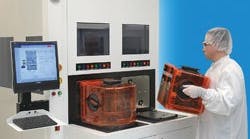Dan Hebert is senior technical editor for Control, Control Design and Industrial Networking. Email him at [email protected].
When a machine builder standardizes its HMI screens, it saves time and money. "The look and feel of our touch panel HMIs are defined by a base set of screens and are consistent from tool to tool and customer to customer," explains Doug Putnam-Pite, director of software development at Owens Design in Fremont, Calif. "We don't need to spend time on projects discussing the software look and feel, as it is already designed and documented."
Owens Design builds custom material handling equipment, primarily for the semiconductor, hard disk drive and photovoltaic industries. It uses Mitsubishi PLCs, Beijer or Mitsubishi touch panels, and PC-based HMI interfaces to control its automation equipment.
"For our PLC code base, we have created a set of reusable, modular, state-based, ladder logic code libraries," Putnam-Pite explains. "We have a library of reusable PLC code modules for servo motors, stepper motors, XY pick and place, and other commonly used control components. We have a PLC design cookbook that our PLC engineers follow to ensure consistent coding and software design standards."
The company also uses modular software for the HMI touch panel interfaces. "We have a base set of modular reusable screens that we reuse from one project to the next," Putnam-Pite adds. "Reusable screen modules include digital I/O displays, motion control displays, and menu navigation systems."
Some screens are used primarily for tool startup and troubleshooting. The I/O displays, for example, allow the user to view all the digital inputs in the tool, and to toggle all the digital outputs.
Owens Design writes its own HMI software for PC platforms. "For tools that require a PC interface, we have a library of .NET C# modules that provide a common look and feel," Putnam-Pite says. "Our diagnostic screens for digital I/O and motion control are both reusable and highly configurable utilizing XML-based configuration files. For common functions such as data logging or database interfaces, we have a library of code that we reuse from project to project."
As with other machine builders, modular software reduces its software development costs. "When we use reusable components, we often save 30% to 40% on software costs, as new software technologies always take much longer than expected," Putnam-Pite says.
This article is part of the February 2013 cover story "Tightly Woven Function Blocks."





